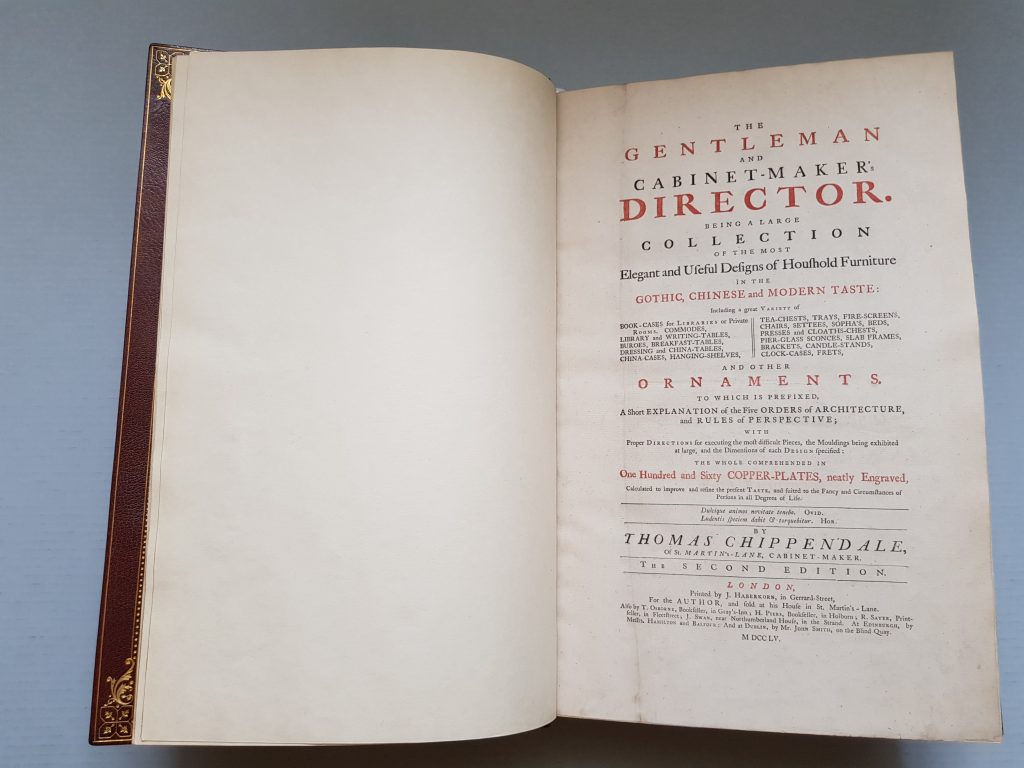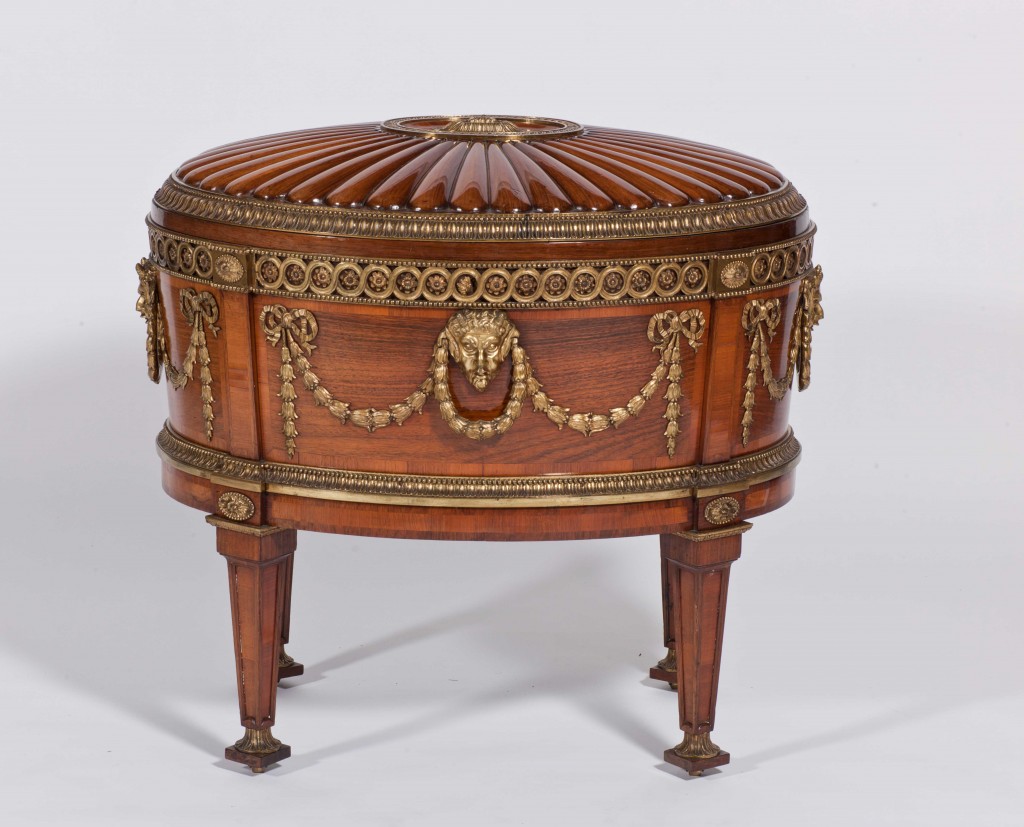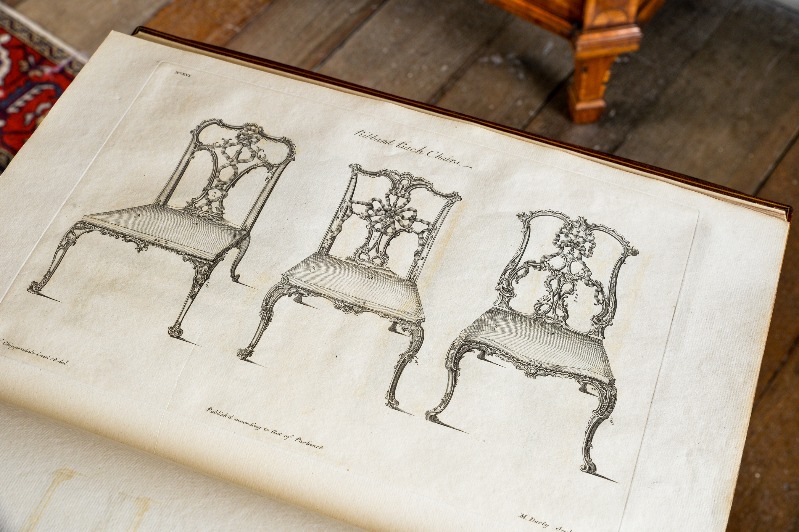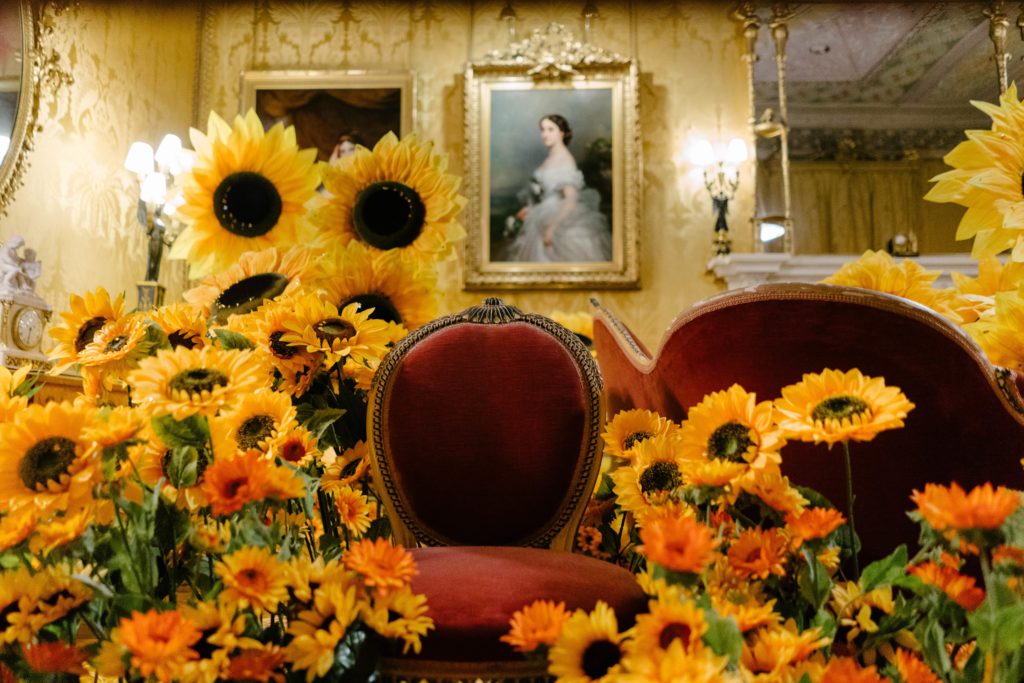The Chippendale tercentenary this year has successfully marked the birth of this famous influential Yorkshire cabinet maker and Harewood House Trust has played a key role in the celebrations. This series of blog posts has charted the success of the year and this is the final post and reflection as commemorations draw to a close.
Thomas Chippendale’s furniture was always original and distinctive yet practical, and his commissions often involved far more than simply supplying furniture – his firm provided upholstery, wall paper, draperies and soft furnishings, as the outstanding Harewood commission demonstrated.
His birth in Otley 300 years ago has been celebrated with a series of events, publications and quality exhibitions throughout the year, across the country, collectively known as Chippendale 300. A legacy of the year-long programme is that the different organisations have all undoubtedly enjoyed working together and plan to continue to do so. The Chippendale Society and Furniture History Society have played an important role in co-ordinating many of the activities, most especially the joint symposium in April in Leeds. Furniture History, the journal of the Furniture History Society, an extensively illustrated scholarly publication, has now been published for 2018. Volume LIV is entirely devoted to Chippendale with two articles cover Harewood’s important commission – one by Adam Bowett entitled Furniture for the Circular Dressing Room at Harewood House and the other by myself, The Chippendale Firm at Harewood: Early Visitors’ Experiences, both revealing new research and encouraging new approaches to the study of his most important lavish commission here at Harewood.
Thomas Chippendale may have been born in a small market town, but he found fame in London, setting up his famous workshop in St Martin’s Lane in 1753, where he attracted wealthy elite patrons who included aristocrats, politicians, merchants, actors and royalty. Some patrons such as Harewood’s Edwin Lascelles employed the Chippendale firm exclusively. Due to the success of his book of designs, the revolutionary Director, first published in 1754 with 160 engraved plates, his work has been copied, emulated, and collected across Europe and America – Catherine the Great owned a copy and an edition came out in French. His fame spread quickly and his name and brand resonate today across the world.
The tercentenary year saw Harewood House Trust acquire a very special second edition of the Director, which had belonged to the 1st Earl of Harewood. This exciting new acquisition was returned to England from America and displayed. A previous blog post on 24 August, was dedicated to the Director and the Trust’s important acquisition. There has always been great interest in the Director internationally and at present there is an excellent, highly informative exhibition, Chippendale’s Director: The Designs and Legacy of a Furniture Maker at the Metropolitan Museum of Art in New York until 27 January 2019, including a selection of more than 200 original Chippendale drawings drawn from their collection.
Chippendale has been described as the Shakespeare of furniture-making and the tercentenary programme of exhibitions and events has highlighted his life and work broadly and innovatively, raising his profile to new heights. Nowhere have the celebrations been greater than here in Yorkshire, the county of his birth, where the bunting came out in Otley throughout June to honour his Baptism Day. The 5 June was celebrated with free admission to Harewood for Otley residents and a special tour, with the annual Chippendale Society Dinner held that warm summer evening at Otley Golf Club.
The programme of celebrations was launched in early February 2018 when Tristram Hunt, Director of the V&A, opened the impressive exhibition Thomas Chippendale: A Celebration of Craftsmanship and Design at Leeds City Museum. This explored the life, work and legacy of the furniture maker, with impressive loans of furniture and original drawings. Harewood House Trust lent generously to the exhibition, including the famous ornate wine cooler c1771, which is part of the Dining Room sideboard suite. There were key loans from Temple Newsam House, Nostell Priory, National Trust, the V&A and Fairfax House, York and from numerous private collections, as well as fine examples from The Chippendale Society’s own extensive collection. The key themes were Style, Customers and Legacy, the latter being a fascinating section which included not only the influence of the Director in spreading Chippendale’s style but also how his reputation has been seen in 20th century popular culture, including an explanation about how The Chippendales dance troupe acquired their name in 1979, meeting in the Destiny II nightclub in Los Angeles, and naming themselves after the club’s Chippendale-style furniture. The exhibition was seen by 35,000 visitors and curated jointly by Adam Bowett and James Lomax of The Chippendale Society. A full lavish accompanying publication was launched in April.
On 22 March, Harewood House Trust opened our long-planned exhibition Thomas Chippendale: Designer, Maker, Decorator exploring Chippendale’s craftsmanship, talent as a designer and furniture maker, as well as his wider role as decorator and the response of early visitors to the interiors. One of the highlights of the exhibition was a new mirrored display of the famous Diana and Minerva Commode, the subject of the first blog post on 25 April. It is the finest of a distinguished group of marquetry furniture that was supplied to Edwin Lascelles in the 1770s. The main feature is the central concave recess, superbly executed enabling a lady to sit in front of is and use the drawers. There was an emphasis in this display on the craftsmanship of the Chippendale firm and the materials used to construct this iconic piece of furniture, from the main mahogany carcass to the thin veneer ground of golden satinwood which has been so carefully hand-cut and inlaid with dyed exotic tropical hardwoods such as rosewood and tulip wood. There was a great response from visitors to this particular display which enabled audiences to look in much more detail at the decorative motifs of swags of husks, repeated garlands of flowering acanthus leaves and radiating fans.

The Diana and Minerva commode, 1773, displayed with mirrored stand as part of the exhibition Designer, Maker, Decorator.
The exhibition sought to reflect how an overall commission of this size and complexity was realised and what was involved from a practical point of view. Chippendale’s surviving bills were displayed including the House Steward Samuel Popplewell’s detailed record in his Day Book from 1769 – 1776, which charts the evolving commission and the practicalities of the wider decorator role. The Day Book describes cabinet maker Samuel James arriving from London in October 1769 and remaining until just before Christmas, busying himself ‘Comeing and going to Leeds prepareing for the Work’, ‘Unpacking and Fixing Furniture’, hanging wallpaper and mirrors, for instance on 2 December spending 10 hours ‘At the Glasses in the Dineing Room’.
He was replaced in March 1770 by the ‘upholder’ William Reid, who made many visits to Harewood from 1771 (the year the Lascelles family moved into their new home) to 1776 spending 856 days altogether working here. For the majority of the time Reid was kept busy, unpacking cases, ‘Fixing Furniture’ which included upholstery and ‘Stuffing the Chaires for the Coffe & Billiard room’, laying carpets, hanging wallpaper, curtains and blinds and applying gold wall borders. It was he who was responsible for making up the State Bed, draping the dome in damask working on the State Bedchamber during the winter of 1773 – 4. He also made protective covers for furniture and the carpets and was sometimes, assisted by two tailors with the upholstery and by John Walker the local Harewood joiner. Our visitors also showed great interest in the fact that the house was opened to the public by appointment and on specified days and the quotes from early visitors ranged from Rev John Wesley, founder of Methodism to the abolitionist William Wilberforce and the pastel painter John Russell, all of whom recorded their initial responses to the lavish Chippendale interiors. Ironically some of the greatest pieces of furniture might well have been protected by the serge covers which the Chippendale firm provided, so none mention the great Diana and Minerva commode, which so fascinates audiences today.
The feedback reflected how engaged visitors became in the displays and enjoyed this behind the scene glimpse of how the interiors were originally created and the early visitors comments on them. They were guided around the State Floor and Below Stairs by a handy guide From Tree to Table, which also took them beyond into the grounds to explore the Tree Trail. This continued the trend over the last few years at Harewood of thematically curating the house and landscape together, which was first developed for the Capability Brown celebrations. Not only did Harewood celebrate Chippendale on his Baptism Day on 5 June but also again on 1 August, Yorkshire Day, with a lecture on his Harewood commission.
Our colleagues from the National Trust at Nostell Priory visited Harewood House in the run up to the centenary programme and we shared our ideas and thoughts on how we planned to celebrate his legacy, both agreeing the importance of contemporary legacy. Their Chippendale, the Man and the Brand opened at Nostell in May, followed in July by their collaboration with Hepworth Wakefield and the artist/designer Giles Round which explored Chippendale’s legacy and the importance of the domestic setting, examining how artists have influenced interior design. Installations created by Round were seen at both locations examining how homes have become important staging grounds for dialogues between art and design.
Meanwhile, further afield at Paxton House in the Scottish Borders another major exhibition opened – The Paxton Style: Thomas Chippendale’s Scottish Achievement, curated by David Jones and Fiona Salveson Murrell, which explored the taste of two Scottish patrons Patrick Home and Ninian Home for their homes Wedderburn Castle and Paxton House and showcased new research. The furniture at Paxton has been described as ‘an exercise in under-stated well-tempered neo-classicism but quietly experimental. The exhibition ran until the end of August and examined the influences on the Chippendale firm and the legacy in Scotland. It included some key loans from Arniston House, Blair Castle, Dumfries House, National Museums of Scotland and the V&A, benefiting from the Weston Loan Scheme for funding. I much enjoyed a tour of the exhibition with Fiona in July, especially taking in some of the drawings from the V&A. If you missed the exhibition, there is an informative catalogue available for sale from Paxton directly. At the end of September a symposium was planned at Paxton, jointly organised, to compare the commissions at Harewood and at Paxton – ‘Neat and Plain’ vs ‘Sumptuous and Ornate’ and we had a key speakers lined up to deliver some fascinating papers but unfortunately, due to the illness of two of the speakers, and rally major train issues planned for that Saturday 29 September, we regrettably had to cancel the event, as those who had tickets would simply not have been able to reach Paxton that day and return. I’d hoped to write up this event as my final blog post but instead, I’ve now had the opportunity to look back over the entire year and reflect on all that has been achieved. It has been a truly memorable year for Chippendale enthusiasts and the general public alike who have warmed to his story and embraced his legacy.
It is especially good to see the Chippendale project reflected as we approach the festive season in the Christmas curation of Harewood, with the State Rooms dressed by Artistic Director Simon Costin this year. Visitors can enter a Christmas dreamscape that extends from the House into the surrounding grounds. In two rooms Chippendale themes are particularly reflected – in the Yellow Drawing Room which is a riot of sunflowers referencing the sunflower motif on the suite of Chippendale furniture there and in the Gallery a large 4.5 m tall Pan created in willow by Dragon Willow is inspired by the god of nature and companion to the nymphs. The figure of Pan is often found as a motif on Chippendale furniture in the house and this willow Pan wends its way through the gallery scattering presents as he goes.
As this is my final blog post on Chippendale, I would like to thank my colleagues in the Harewood Collections and wider teams. I am especially grateful to Christie’s for their support of this blog and the Chippendale Society, specifically Adam Bowett and James Lomax, who have given so much to support to us all but have been particularly helpful to me in thinking through new ideas about the reception of Chippendale’s commission at Harewood.
It has been an exciting year, taking me to lecture across the country and perhaps most memorably at Dumfries House and here at Harewood on Yorkshire Day, both on very hot days and of course contributing my paper to the symposium day in Leeds. It’s been a privilege to serve on the Chippendale 300 Steering Group, meeting regularly with colleagues and I am sure we will get back together to share experiences of this remarkable year. I hope you have enjoyed this tercentenary journey with updates on the blog about key works in Harewood’s collection, new research, events and interviews with key scholars and that with Geraldine here today, hearing how a contemporary artist has responded to this master craftsman, his story and his work.
Thank you for taking the time to read these blogs and share knowledge of and interest in Chippendale.
With special thanks to Christie’s for their sponsorship of the Chippendale 300 blog series.
![]()




